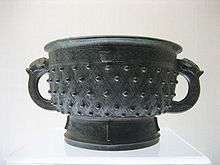Bianzhong of Marquis Yi of Zeng

The Bianzhong of Marquis Yi of Zeng (simplified Chinese: 曾侯乙编钟; traditional Chinese: 曾侯乙編鐘; pinyin: Zēnghóuyǐ Biānzhōng), or Zenghouyi Bells, is the name given to an ancient musical instrument made of bells (called bianzhong) unearthed in 1978 in the Zeng-hou-yi Tomb in Sui County, Hubei Province, China. The bianzhong were made in 433 B.C.
The bianzhong are hung on two sets of wood racks. One rack is 7.48 meters long X 2.65 meters wide. the other rack is 3.35 meters long X 2.73 meters wide. The two racks are perpendicular to each other.
The bianzhong are constituted by altogether 64 bells, which are hung at three levels and are divided into eight groups. There are 19 bells in three groups at the top level. There 33 bells in three groups at the middle level. There are 12 bells in two groups at the bottom level.
The biggest bell is of 153.4 cm height and 203.6 kg weight. The smallest bell is of 20.4 cm high and 2.4 kg weight.
Each bell in the Bells can play two tones with three degrees' interval between them. The tonal range of Zenghouyi Bells is from C2 to D7. In the middle area of the tonal range, it can play all twelve half tones.
The wood hammers used to strike the bells were unearthed from the Zeng-hou-yi Tomb as well.
The original bells are currently on display at the Hubei Provincial Museum in Wuhan. Copies have been made for other museums.
See also
Further reading
- Lee, Yuan-Yuan and Shen, Sinyan. (1999). Chinese Musical Instruments (Chinese Music Monograph Series). Chinese Music Society of North America Press. ISBN 1-880464-03-9
- Shen, Sinyan (1987), Acoustics of Ancient Chinese Bells, Scientific American, 256, 94.
- von Falkenhausen, Lothar. (1993). Suspended music: chime-bells in the culture of Bronze Age China. University of California Press.
